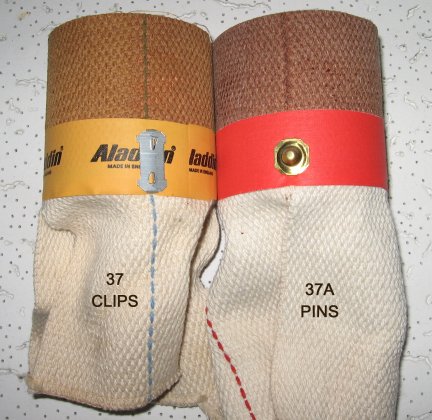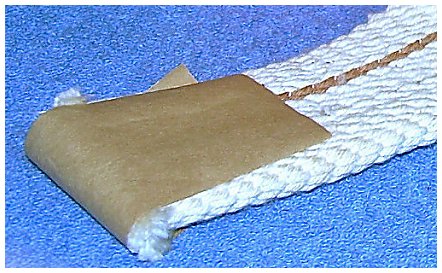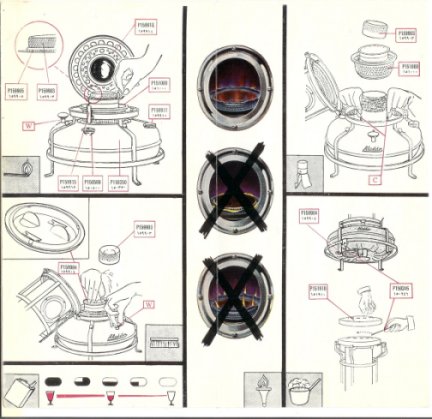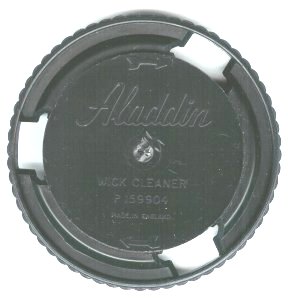
Note: Aladdin's instructions, even those printed on new boxes, say
"8. Tear paper tabs from wick." Aladdin wicks used to have paper tabs on the bottom of the wick tails, as shown at right. New wicks do not have the paper tabs but the directions have not changed, driving people nuts trying to find some paper to remove.

The instructions below were taken verbatim from a 1960's Aladdin Blue Flame Manual.
"Paraffin" is what in the US is known as 1K clear kerosene. A much more complete Blue Flame Owner's manual in Adobe format was kindly provided by Monte Brueggeman. Also Aladdin Blue Flame Owner's Manual, multilingual, in English, French, German, Dutch, Italian, Spanish and Arabic. Kindly provided by Carlos Duarte in Paraguay.
or
This heater is manufactured in accordance with British Oil Heater Regulations 1966, British Standard 3399:1963 and other national and international safety standards and regulations where relevant. However heat is produced carelessness and ignorance can cause accidents so, for your own comfort and safety, please read and understand these instructions before lighting your heater. The numbers in brackets in the text will help you identify parts on the illustrations. The illustrations are on the last page and are identified by symbols in the margins of the text.

UNPACKING
We have been generous with the packing to make sure that your heater gets to you without damage; make sure you remove all the packing before you start.
FILLING
The tank (P150350) will hold one Imperial gallon (1.2 U.S. gallons or 4-5 litres), and you must use only the best quality paraffin (domestic kerosine). It is very dangerous to use any other fuel, including power kerosine or gasoline. In the British Isles use Aladdin Pink paraffin. Remember, put absolutely nothing but clean domestic paraffin in your tank or storage container and make sure it cannot become contaminated in any way. The filler cap (P159911) unscrews. The oil gauge (P150500) indicates the approximate amount of fuel in the tank and will warn you when the heater needs refilling. Don't burn the heater dry because it will seriously shorten the life of the wick. The black symbol shows that the heater is full.
LIGHTING
When you use the heater for the first time, or have fitted a new wick, do not light it for at least an hour so that the wick has a chance to soak up enough paraffin. Release the clip (P159915) and open the heater. There should be a flame spreader (P159903) which has a lot of small holes in it, fitted in the center tube of the tank. If it has fallen out or is not seated properly it must be replaced and pushed fully home before the heater is lit. Make sure the burner basket (P1599905) is locked fully into the tank. The wick winder "W" turns clockwise to raise the wick (P159905) with just enough wick showing (you should still see five rows of holes on the flame spreader), light the wick all the way around and close the heater, checking carefully that the clip (P159915) is properly fastened. The burner reaches working temperature very quickly, so you should immediately adjust the wick to give you the required heat within the limits of the SAFE BLUE FLAME.
THE SAFE BLUE FLAME

Remember that your safety indicator is the colour of the flame. When the flame is a clear blue all over you have got the SAFE BLUE FLAME. When the flame shows any yellow the wick is too high or too low or something is wrong with the heater; never let the heater burn like this. This visual safety indicator is so important and so simple to use that a little practice at first will amply repay you. Short periods of yellow flame are not dangerous so you can safely try the settings for yourself.
Turn the wick winder anti-clockwise until the heater is almost out and you will get a flickering yellow flame; this is too low. Raise t he wick until a completely blue flame is obtained and then raise a little more so that it cannot revert to yellow; this is the lowest setting for the SAFE BLUE FLAME. As you turn the wick up more the blue flame will grow and you may notice a reddish glow above the flame and possibly intermittent red flecks of burning dust. This is quite normal. Eventually yellow spikes will appear at the top edge of the flame to warn you that you have gone too far. Lower the wick until you get rid of the yellow spikes and you now have the highest setting for the SAFE BLUE FLAME.
LEAVING THE HEATER
As long as you have the SAFE BLUE FLAME you can confidently leave your heater unattended, but do take a few simple precautions against accidents. Place the heater out of draughts and where it can't be knocked over. Make sure that children cannot play with it. You and the heater both need oxygen so always provide adequate ventilation to ensure you both get enough.
EXTINGUISHING
After you have turned the wick down to extinguish the heater, turn it up again and look to make sure it is really out.
USING THE WICK CLEANER

A good flame depends on a clean wick. The wick should not be cleaned until it has been used for 50 hours or more. Thereafter, about once a week remove the flame spreader (P159903), turn the wick right down, and put the wick cleaner (P159904) in its place the right way up. Whilst turning the wick cleaner clockwise with one hand, slowly turn the wick up with the other. Maintain a gentle downward pressure on the wick cleaner to keep it level and touching the rim of the burner basket (P151000). When the rising wick reaches the cleaner, black carbon will come through the three holes. This will soon stop and your wick will be clean and properly shaped for further use.
Wipe the rim of the burner basket clean before replacing the flame spreader. The wick must be kept shaped at the correct angle and this can only be done with the wick cleaner provided. Never use scissors, razor blades, etc.
CLEANING THE HEATER
A dirty heater may smell and can even be dangerous, particularly if fluff or carbon is blocking any of the air holes. Wipe off any paraffin which as been spilt during filling and clean regularly to get rid of all dust, fluff and carbon. Take out the flame spreader (P159903) and burner basket (P151000) for cleaning and don't forget to clean the gallery (P159918) which can be seen at the bottom of the chimney when the heater is open. Hot soapy water can be used as long as none gets in the tank or on t he wick, but you must never use abrasives.
RESHAPING THE WICK
If the top edge of the wick becomes unevenly burnt away and one side of the flame is much higher than the other, or burning yellow, you must not use the heater until the wick has been reshaped. Put the heater where the smell won't matter, and let it burn completely out. Careful use of the wick cleaner now, and for the next day or two of normal burning, will fully restore the shape of the wick.
FITTING NEW WICK
Carefully used, your wick will last a remarkably long time, but when it will no longer turn up enough get a new one - forcing the wick winder will only result in an unnecessary repair bill. If you don't like handling a wet wick, burn the heater dry, but remember that it will smell.
Take out the flame spreader (P159903) unscrew the burner basket (P151000) and turn the wick up fully. [English Blue Flame. You will see that two arms "C" hold the wick. Pull them apart and move one towards and one away from you. Pull off the old wick and replace the flame spreader.] [Japanese Blue Flame. Turn the wick up until the cog is free and then pull the wick and carrier out of the tank. Disengage the teeth on either side of the wick by pressing the top of the wick above the teeth and draw the old wick out of the carrier.]
Handle the new wick carefully so that you do not damage the top edge and ease it down until the brass studs can be re-engaged with the holes in the wick carrier arms "C". If the wick tail on the winder side has been caught up in the raiser mechanism inside the tank, free it so that it reaches the bottom. Refill the tank and let the wick soak for an hour before lighting the heater.
During the past 30 years, millions of people have used Aladdin heaters with complete satisfaction. Recently, however, many people have told us of the serious troubles they have experienced with their heaters owing to the fact that they have been persuaded to use wicks not of our manufacture and not marked Aladdin. These wicks are not suitable for Aladdin heaters. It is in your interest to refuse such wicks, because we cannot accept any responsibility for the performance or reliability of any of our appliances unless genuine Aladdin spare parts are used.
COOKING
If you want to boil water or cook, remove the top cover (P151910) to expose the boiling ring. In some export models a lifting tool (P150246), which fits into one of the holes in the top cover is provided with the heater and is housed underneath the tank, where the wick cleaner is also then housed.
MAINTENANCE
Replace any damaged or worn out part immediately with a genuine Aladdin spare - we cannot accept any responsibility if substitutes are used.
Once a year you should rinse out the tank with clean paraffin and fit a new wick.
If you cannot get the SAFE BLUE FLAME or are in any difficulty, take the heater to your nearest Aladdin stockist. Never use a heater which is not working properly.
POINTS TO REMEMBER
1. Use paraffin (domestic kerosine) only - petrol (gasoline) is dangerous.
2. Don't add salt or anything else to the fuel - it's useless and harmful.
3. Don't fill or carry the heater whilst it is alight.
4. Don't dry clothes over, or too near, the heater.
5. Always provide adequate ventilation.*
6. Maintain the SAFE BLUE FLAME. If you can't - but the heater out!
7. Replace damaged parts immediately.
8. Use only Aladdin spares - others can be dangerous.
9. Watch where you put it - particularly with children around.
10. Don't use in a draught.
*Most rooms are adequately ventilated if there is an unblocked flue or an air brick together with a fanlight or window slightly open. NEVER USE YOUR OIL HEATER IN A ROOM WHICH HAS BEEN COMPLETELY SEALED AGAINST DRAUGHTS.
SPECIFICATIONS
Heat output = BTU's per hour = 5,870 to 9,320.
Equivalent to 1 3/4 - 2 3/4 kilowatts.
Consumption = 25 - 16 hours per gallon.
Approximate capacity = one gallon (4 - 5 liters)
